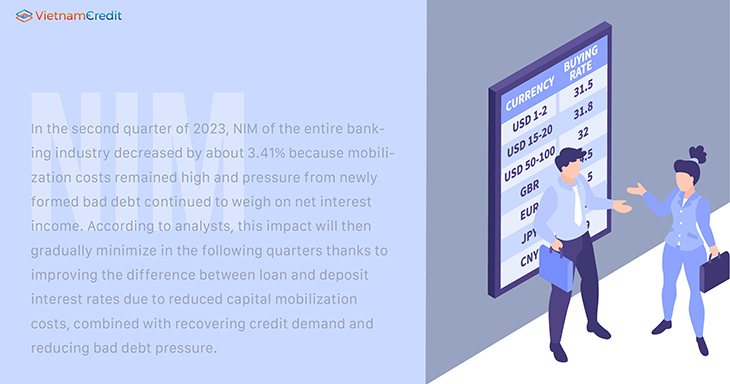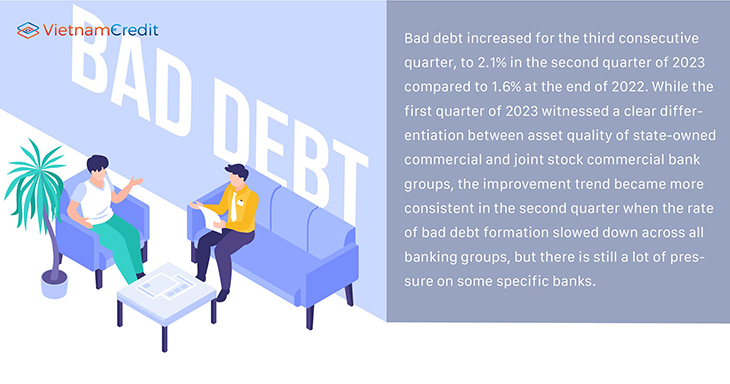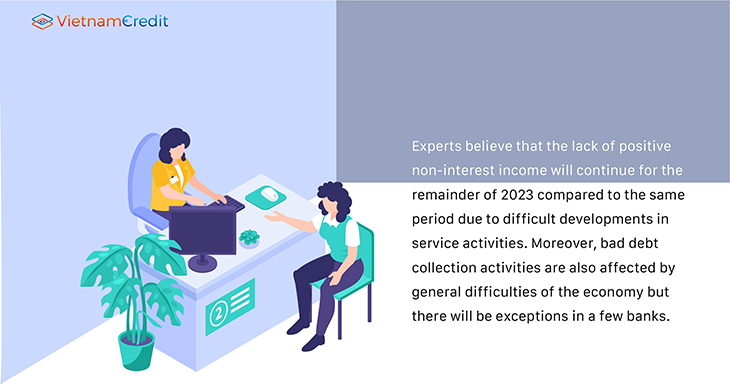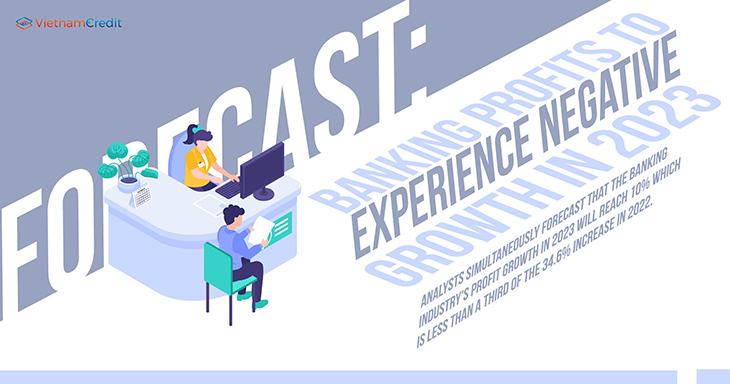Analysts simultaneously forecast that the banking industry's profit growth in 2023 will reach 10% which is less than a third of the 34.6% increase in 2022.
Nim to recover by year-end
In the second quarter of 2023, NIM of the entire banking industry decreased by about 3.41% because mobilization costs remained high and pressure from newly formed bad debt continued to weigh on net interest income. According to analysts, this impact will then gradually minimize in the following quarters thanks to improving the difference between loan and deposit interest rates due to reduced capital mobilization costs, combined with recovering credit demand and reducing bad debt pressure.

Specifically, mobilization costs will gradually decrease in the third quarter of 2023 (because the majority of the mobilization structure of most banks is short-term deposits from 3 to 6 months, so it will more clearly reflect the impact of cutting listed deposit interest rates from March 2023). This effect will continue in the fourth quarter of 2023 when mobilization costs are expected to remain flat or may still decrease slightly in the scenario where the State Bank announces another interest rate cut.
With mobilization costs starting to gradually decrease from the second quarter and likely to bottom out in the third quarter, lending interest rates will follow a downward trend at a slower pace from the third quarter due to the delay in interest rate re-pricing of about 3 to 6 months.
Credit demand slowed down in the first half of 2023 in most industries, however, VDSC, ACBS, TPS all forecast that industry-wide credit growth will recover at about 12% for the whole year 2023 (lower than 14.5% in 2022) when (1) credit demand in industrial, manufacturing, trade, and service sectors recovers from improved import-export and consumption dynamics, and (2) more positive signals of the real estate market from the fourth quarter of 2023 when interest rates decrease.
Real estate-related credit has been the driving force of total credit growth for many years, accounting for about 20% of outstanding credit, so lending interest rates for home loans returning to preferential levels, and projects about to be launched later this year may continue to be the engine driving credit demand of developers and individuals in the second half of 2023 and 2024.
Bad debt increased for the third consecutive quarter, to 2.1% in the second quarter of 2023 compared to 1.6% at the end of 2022. While the first quarter of 2023 witnessed a clear differentiation between asset quality of state-owned commercial and joint stock commercial bank groups, the improvement trend became more consistent in the second quarter when the rate of bad debt formation slowed down across all banking groups, but there is still a lot of pressure on some specific banks.

Analysts all believe that NIM will remain relatively stable in the third quarter compared to the second quarter level while the last quarter of 2023 will see a more significant recovery, but the full year results will still record a decline compared to the higher base in 2022.
In addition, the limit on the ratio of short-term capital for medium and long-term loans (SFL) to 30% from October this year compared to the previous threshold of 34% may affect some banks with high lending ratios. In case these banks re-adjust their portfolios to reduce the proportion of medium and long-term loans, NIM may be adversely affected because interest rates on medium and long-term loans are often higher.
Non-interest income is less positive
According to VDSC, non-interest income accounts for 25%, contributing to the growth of total operating income of the banking industry in the past 5 years. However, this income is recording a decline of up to 10% in the first 6 months of 2023.
This decrease in the first 6 months of 2023 comes from two factors including the impact of the slowdown in credit growth on the bank's cross-selling products and debt collection activities in other income components slowing down due to the difficult economic context.
Specifically, in the first 6 months of 2023, service income for the entire industry recorded -2.6% over the same period, other income recorded -15% over the same period. On the contrary, income from foreign exchange trading recorded a growth rate of 8% over the same period and income from securities activities went sideways supporting the decline in non-interest income.

Experts believe that the lack of positive non-interest income will continue for the remainder of 2023 compared to the same period due to difficult developments in service activities. Moreover, bad debt collection activities are also affected by general difficulties of the economy but there will be exceptions in a few banks.
Income from bancassurance will slow down, however, it is expected that income from this activity will become positive again when inspection activities and the legal framework are complete, and banks and insurance companies improve service quality and increase awareness of protecting customer rights, thereby creating motivation for recovery for this product that still has a lot of room.
Income from debt collection activities will slow down in the remaining period of 2023 because a large proportion of banks' collateral for liquidation is real estate. However, it is expected that this income will be positive in the medium term when the economy recovers, contributing more to non-interest income growth.
The positivity from securities operating income amid the decline in Government bond yields will support the profits of some banks.
The highlight is that the banking industry continues to control operating costs well over time with the CIR ratio continuously improving over the years since 2017 until now through the digital transformation process. In the first 6 months of 2023, operating cost growth at a low level of 9% YoY (1H2022: 15% YoY) in the context of modest total operating income growth still ensures that the CIR ratio remains flat compared to 1H2022.
Operating expenses in the remaining period of the year will increase again, however the CIR ratio will still be actively controlled in accordance with the recovery of total operating income.
Source: VDSC, ACBS, TPS
Compiled by VietnamCredit

























































